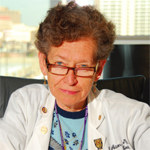Among patients with systemic lupus erythematosus (SLE), lupus nephritis is one of the more common health problems and a leading cause of mortality. In adults with SLE, as many as five of 10 will develop kidney disease. In children with lupus, eight of 10 will develop kidney disease.1
Lupus nephritis appears to be more prevalent in Asians, African Americans and Hispanics than in other races and ethnic groups.2-6 Up to 60% of patients with SLE in these groups develop renal disease of differing severity during the course of their illness.
Lupus nephritis can cause hypertension and kidney failure. Patients with lupus nephritis also have a higher risk of heart and blood vessel problems as a well as a higher risk of developing cancer, especially B cell lymphoma, than their counterparts without lupus nephritis in the general population.7
Both SLE and lupus nephritis reduce a person’s life expectancy, with SLE cutting an average of 12.4 years off a person’s life expectancy and lupus nephritis reducing life expectancy by another 2.7 years, according to a study by Mok et al. “Thus, the occurrence of renal damage is an important adverse factor for survival in patients with SLE,” they wrote.8
The kidney damage caused by lupus nephritis is irreversible and associated with renal failure, cardiac events and death.9
Treatment
Rheumatologists had few treatment options for patients with lupus nephritis until December 2020, when belimumab was approved by the U.S. Food & Drug Administration (FDA). A few weeks later, in January 2021, the FDA also approved voclosporin, a calcineurin inhibitor, to be used in combination with background immunosuppressive therapy to treat adults with active lupus nephritis.10,11
Treatment is aimed at reducing symptoms, preserving kidney function and avoiding the need for dialysis or kidney transplant, reducing morbidity and mortality, and minimizing medication-related toxicities.
Clinical Guidance
Today, clinicians also have a new evidence-based guideline from the ACR to reference for the screening, treatment and management of lupus nephritis.
“Important goals of this guideline are to provide substance and direction for therapy decisions after clinician-patient discussions, and to encourage close working relationships between rheumatologists and nephrologists to enhance collaborative care,” wrote the guideline authors.
Further research is needed, and more treatment options would be welcome, but it’s important to recognize the progress that has been made to date in the treatment and monitoring of patients with lupus nephritis.



